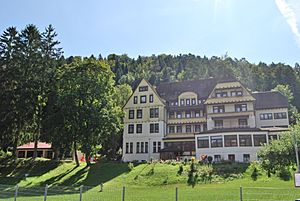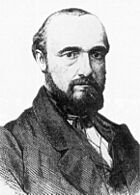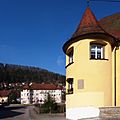Sulz am Neckar facts for kids
Quick facts for kids
Sulz am Neckar
|
||
|---|---|---|

Free Baptist Church in Sulz am Neckar
|
||
|
||
| Country | Germany | |
| State | Baden-Württemberg | |
| Admin. region | Freiburg | |
| District | Rottweil | |
| Elevation | 443 m (1,453 ft) | |
| Population
(2022-12-31)
|
||
| • Total | 12,724 | |
| Time zone | CET/CEST (UTC+1/+2) | |
| Postal codes |
72168–72172
|
|
| Dialling codes | 07454 | |
| Vehicle registration | RW | |
| Website | www.sulz.de | |
Sulz am Neckar is a town in Germany. It is located in the Rottweil district in the state of Baden-Württemberg. The town sits on the Neckar river. It is about 22 kilometers (14 miles) north of Rottweil. It is also 19 kilometers (12 miles) southeast of Freudenstadt.
Sulz am Neckar became part of the Hohengeroldseck family's lands in the year 1242.
A large power line crosses the Neckar Valley near Sulz. This line carries electricity for trains. It is held up by two tall towers, each 61 meters (200 feet) high.
Contents
Discovering Sulz am Neckar's Location
Where is Sulz am Neckar Located?
The city of Sulz am Neckar is found between two famous German regions. These are the Black Forest and the Swabian Jura mountains. It is also located between the cities of Stuttgart and Lake Constance. The town sits along the Neckar river. Its elevation ranges from 410 to 675 meters (1,345 to 2,215 feet) above sea level.
Sulz has the largest area of any town in the Rottweil (district). Its total size is 87.60 square kilometers (33.82 square miles).
How Sulz am Neckar is Organized
The city of Sulz is made up of its main town area. This includes two smaller parts called Sulz-Kastell and Sulz-Schillerhöhe. There are also nine other districts that belong to Sulz. These districts are Bergfelden, Dürrenmettstetten, Fischingen, Glatt, Holzhausen, Hopfau, Mühlheim, Renfrizhausen, and Sigmarswangen.
A Look at Sulz am Neckar's Past
Early Beginnings of Sulz
People lived in the Sulz area a very long time ago. The first signs of people here are from the time of the Celts. We know this from old burial mounds and a square area they built.
Around 74 AD, the Romans built a military camp. This camp, called Fort Sulz, was on a hill south of where the town is today. Now, the Sulz-Kastell district, with its factories, is in that spot.
The town was first written about in the year 790. It was called "villa publica Sulza." The name "Sulz" comes from its salt springs. These springs, which produced salty water, were very important to the town for hundreds of years. The first owners of the saltworks (places where salt was made) were the Counts of Sulz in the 11th century.
Later, around 1250, the Lords of Geroldseck took control of the town and its saltworks. The Counts of Sulz lost most of their power. The Lords of Geroldseck also built Burg Albeck, a castle southwest of the city. In 1284, King Rudolf of Habsburg gave Sulz its town privileges. This meant it had special rights as a town.
Between 1301 and 1473, a branch of the Geroldseck family lived in Sulz. However, they faced money problems. In 1473, they had to sell the town to Württemberg.
After Duke Ulrich of Württemberg was forced out in 1519, the Lords of Geroldseck briefly ruled again. But this ended in 1534 when the duke returned. The Geroldseckers only kept the title "von Geroldseck und Sulz." The city itself burned down almost completely twice. This happened in 1581 and again in 1794. It took two years to rebuild each time. French soldiers also robbed the town many times during these periods.
One of Sulz's districts, Mühlheim, was mentioned even earlier. It appeared in the Lorsch Codex in 772 as Muliheim.
Sulz in the 19th and 20th Centuries
For a long time, Sulz was the only place in Württemberg that made salt. In 1803, other saltworks that made much more salt became part of Württemberg. Because of this, Sulz lost its main role as a salt-producing town. However, it remained an important administrative center. It was the seat of the Oberamts Sulz, a local government office.
In 1867, a railway line was built to Sulz. This connected the town to the train network. This helped Sulz stay connected to other areas.
In 1938, during a government change, the district of Sulz was closed. It became part of the Horb district.
Towards the end of World War II, a small camp was set up in Sulz am Neckar. It was connected to a larger concentration camp. During this difficult time, some people were held there.
After World War II, Sulz became part of the French occupation zone. In 1947, it joined the new state of Württemberg-Hohenzollern. This state later became part of Baden-Württemberg in 1952.
During a district reform, Sulz became part of the Rottweil district. It also became part of the Freiburg region.
From 1963 to 1993, the German army had a supply base in Sulz.
To remember its history with salt, the town's outdoor swimming pool is now filled with salt water. This makes it the only salt water outdoor pool in the area.
Joining Forces: Sulz's Incorporations
Over time, several nearby towns joined Sulz am Neckar. This happened as part of a local government reform in Baden-Württemberg.
- January 1, 1972: Bergfelden, Hopfau, and Mühlheim am Bach joined.
- March 1, 1972: Fischingen joined.
- January 1, 1974: Holzhausen, Renfrizhausen, and Sigmarswangen joined.
- January 1, 1975: Dürrenmettstetten and Glatt joined.
Religions in Sulz am Neckar
Since the Reformation, Sulz has been mainly Protestant. The Lutheran church in Sulz has seven smaller churches. The districts of Fischingen and Glatt also have their own Lutheran churches. All of these belong to the Protestant deanery of Sulz. Sulz is also home to the Sulz church district of the Evangelical-Lutheran Church in Württemberg.
The Roman Catholic Church disappeared from Sulz during the Reformation in the 1500s. But after World War II, more Catholics moved to Sulz. So, a Catholic church was started again. The St. Johannes Evangelist church was built in 1950. This Catholic church belongs to the Rottweil deanery.
Other religious groups also have communities in Sulz. These include the Volksmission entschiedener Christen, the Freie Baptisten Gemeinde Sulz, a New Apostolic Church, and a group of Jehovah's Witnesses. There is also an Islam community.
Sister Cities of Sulz am Neckar
Sulz am Neckar has special partnerships with two other towns. These are called town twinnings.
- Montendre, in the Charente-Maritime area of France.
- Altenberg, in Saxony, Germany.
Economy and Getting Around in Sulz
How to Travel to and from Sulz
Sulz is on the Plochingen–Immendingen railway line. It is a stop for Regional-Express and Intercity trains. Trains run every hour to Stuttgart and Rottweil. There are also trains every two hours to Singen. Sometimes, you can even find direct trains to Konstanz and Villingen.
You can reach Sulz by car using the Bundesautobahn 81 highway. This highway goes from Würzburg to Gottmadingen. The Bundesstraße 14 road also passes through Sulz. Sulz is about 60 kilometers (37 miles) from Stuttgart. It is about 100 kilometers (62 miles) from Bodensee (Lake Constance).
Sulz has a small airfield for ultralight aircraft. There is also a special radio beacon called VOR Sulz (116.10 MHz). This beacon helps airplanes navigate.
Schools and Learning in Sulz
Sulz am Neckar has several schools and educational places:
- Albeck-Gymnasium (a high school)
- Lina-Hähnle-Realschule (another type of secondary school)
- Primary and secondary school with Werkrealschule (a school for younger students)
- Elly-Heuss-Knapp school, commercial schools Sulz with commercial high school (schools focused on business)
- Adult education centre (for adult learning)
Fun and Sports in Sulz
- Outdoor pool susolei: This is a swimming pool filled with brine (salt water). It's a unique place to swim!
Culture and Things to See in Sulz
Sulz is located on two scenic routes. These are the Hohenzollernstraße and the Römerstraße. They lead past many interesting sights:
- The Stone Fountain Stock of the Market Square Fountain: This fountain from 1807 has decorated metal plates.
- Epitaphs of the old cemetery: These are old memorial stones from a cemetery started in 1542.
- Bronze tomb of Anna von Hohengeroldseck: This tomb from 1533 is in the Sulzer Stadtkirche (city church). It belongs to Anna and her son Walter.
Museums to Explore
- Gustav Bauernfeind-Museum: This museum is in the building at Untere Hauptstraße 5.
- Cultural and museum centre in Glatt castle: A place to learn about culture and history, located in a castle.
- Römerkeller-Museum: This museum is in the area where the old Roman Fort Sulz used to be. It shows Roman history.
- The studio of the art foundation Paul Kälberer: Located in the Glatt district, this studio shows paintings and drawings by the artist Paul Kälberer.
Important Buildings and Structures
- The castle of today's Ruin Albeck: This castle was built in the late 1200s by Baron von Geroldseck. It was destroyed by French soldiers in 1688.
- The Kirchberg convent: This used to be a Dominican convent. Today, it is a Protestant meeting and retreat house.
- The Bernsteinschule: This was once an art academy. It is in the former convent of the Franciscan friars in Bernstein.
- The 24-meter (79-foot) high observation tower Mettstetten: Built in 1998, this tower is near the Dürrenmettstetten district. Its viewing platform is exactly 700 meters (2,297 feet) above sea level.
Famous People from Sulz am Neckar
- Sixtus Riessinger (around 1440 - around 1505): A German printer who worked in Italy.
- Salomon Schweigger (1551–1622): A Lutheran religious scholar and traveler.
- Joseph Gottlieb Kölreuter (1733-1806): A botanist who studied plants and flowers.
- Friedrich August von Alberti (1795-1878): A geologist who studied rocks and the Earth.
- Carl Reinhold August Wunderlich (1815–77): A doctor and a pioneer in psychiatry.
- Gustav Bauernfeind (1848–1904): A famous painter, illustrator, and architect known for his Orientalist art.
- Lina Hähnle (1851–1941): A very important person in bird conservation.
- Richard Schmid (1899–1986): A lawyer and politician who was part of the German resistance.
- Brigitte Peterhans (1928-2021): A German-American architect.
Gallery
-
Epitaph (memorial stone) for Magnus Friedrich Roos
See also
 In Spanish: Sulz am Neckar para niños
In Spanish: Sulz am Neckar para niños







